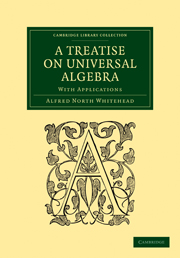Book contents
- Frontmatter
- PREFACE
- Contents
- BOOK I PRINCIPLES OF ALGEBRAIC SYMBOLISM
- CHAPTER I ON THE NATURE OF A CALCULUS
- CHAPTER II MANIFOLDS
- CHAPTER III PRINCIPLES OF UNIVERSAL ALGEBRA
- BOOK II THE ALGEBRA OF SYMBOLIC LOGIC
- BOOK III POSITIONAL MANIFOLDS
- BOOK IV CALCULUS OF EXTENSION
- BOOK V EXTENSIVE MANIFOLDS OF THREE DIMENSIONS
- BOOK VI THEORY OF METRICS
- BOOK VII APPLICATION OF THE CALCULUS OF EXTENSION TO GEOMETRY
- Index
CHAPTER I - ON THE NATURE OF A CALCULUS
Published online by Cambridge University Press: 29 August 2010
- Frontmatter
- PREFACE
- Contents
- BOOK I PRINCIPLES OF ALGEBRAIC SYMBOLISM
- CHAPTER I ON THE NATURE OF A CALCULUS
- CHAPTER II MANIFOLDS
- CHAPTER III PRINCIPLES OF UNIVERSAL ALGEBRA
- BOOK II THE ALGEBRA OF SYMBOLIC LOGIC
- BOOK III POSITIONAL MANIFOLDS
- BOOK IV CALCULUS OF EXTENSION
- BOOK V EXTENSIVE MANIFOLDS OF THREE DIMENSIONS
- BOOK VI THEORY OF METRICS
- BOOK VII APPLICATION OF THE CALCULUS OF EXTENSION TO GEOMETRY
- Index
Summary
Signs. Words, spoken or written, and the symbols of Mathematics are alike signs. Signs have been analysed into (α) suggestive signs, (β) expressive signs, (γ) substitutive signs.
A suggestive sign is the most rudimentary possible, and need not be dwelt upon here. An obvious example of one is a knot tied in a handkerchief to remind the owner of some duty to be performed.
In the use of expressive signs the attention is not fixed on the sign itself but on what it expresses; that is to say, it is fixed on the meaning conveyed by the sign. Ordinary language consists of groups of expressive signs, its primary object being to draw attention to the meaning of the words employed. Language, no doubt, in its secondary uses has some of the characteristics of a system of substitutive signs. It remedies the inability of the imagination to bring readily before the mind the whole extent of complex ideas by associating these ideas with familiar sounds or marks; and it is not always necessary for the attention to dwell on the complete meaning while using these symbols. But with all this allowance it remains true that language when challenged by criticism refers us to the meaning and not to the natural or conventional properties of its symbols for an explanation of its processes.
- Type
- Chapter
- Information
- A Treatise on Universal AlgebraWith Applications, pp. 3 - 12Publisher: Cambridge University PressPrint publication year: 2009First published in: 1898



